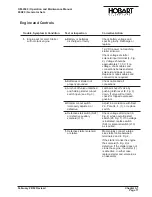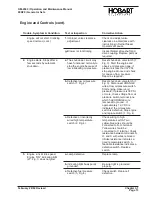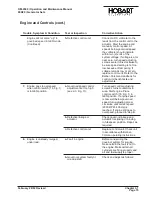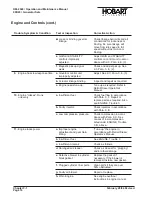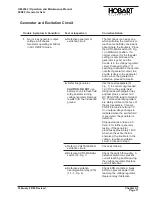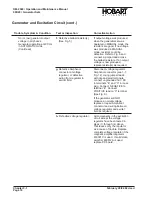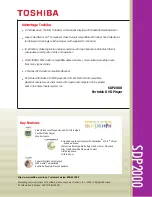
•
Underfrequency relay trips at 375 to 385 Hz, resets at 385 Hz.
•
Overload relay trips at 125% rated load in 5 minutes.
See 2-3 Fig. 13 for typical test values at test receptacle and test box.
7. Check Connections and Leads
ALWAYS make a check of connections and leads to a component suspected of being faulty. With the
exception of a few instances, we will assume that connections and wiring have always been checked
first and that power has not been lost as a result of defective wiring or connections.
8. Electric Governor Trouble Shooting
The following facts concerning the operation of the electric governor may be helpful in understanding the
system and in determining which unit in the system is faulty in case of troubles.
a. The system requires two sources of power to operate normally.
(1)
12-V DC input power (from engine electrical system)
(2)
AC input power (from magnetic pickup)
b. Assuming other conditions are normal, the actuator will go to, or remain in, IDLE position
under the following conditions.
(1)
No 12-V DC power to control box.
(2)
No voltage from control box to actuator.
(3)
No signal from magnetic pickup.
c. The actuator will “surge” under the following conditions:
(1)
“Stability” or “gain” adjustment set too “high”.
(2)
Throttle linkage binding.
9. Engine Trouble Shooting Procedures
a. General
The following engine troubleshooting procedures were taken from Detroit Diesel’s “Field Service
Data Book”. Certain abnormal conditions which may interfere with satisfactory engine operation,
together with methods of determining the cause of such conditions, are covered in the Trouble
Shooting Chart.
The ability of the engine to start and operate properly depends primarily on two things:
(1)
The presence of an adequate supply of air, compressed to a sufficiently high compression
pressure.
(2)
The injection of the proper amount of fuel at the right time.
Lack of power, even running, excessive vibration, stalling, and hard starting may be caused by
low compression, faulty injection in one or more cylinders, faulty timing or valves, or lack of
sufficient air.
Since proper compression, fuel injection, and the proper amount of air are important to good
engine performance, procedures for checking them are given here.
b. Locating a Misfiring Cylinder
(1)
Start engine and allow it to run until it reaches normal operating temperatures.
(2)
Remove valve cover.
(3)
Run engine at IDLE speed and check valve clearance.
(4)
Hold the No. 1 injector follower down with a screwdriver, or with a special injector cut-out tool,
thus preventing operation of the injector.
OM-2040 / Operation and Maintenance Manual
90D20 / Generator Sets
February 28/94 Revised
Chapter 3-1
Page 3
Summary of Contents for 6921 Series
Page 2: ...This page intentionally left blank ...
Page 223: ......
Page 224: ......
Page 225: ......
Page 226: ......
Page 227: ......
Page 228: ......
Page 229: ......
Page 230: ......
Page 231: ......
Page 232: ......
Page 233: ......
Page 234: ......
Page 235: ......
Page 236: ......
Page 237: ......
Page 238: ......
Page 239: ......
Page 240: ......
Page 241: ......
Page 242: ......
Page 243: ......
Page 244: ......
Page 245: ......
Page 246: ......
Page 247: ......
Page 248: ......
Page 249: ......
Page 250: ......
Page 251: ......
Page 252: ......
Page 253: ......
Page 254: ......
Page 255: ......
Page 256: ......
Page 257: ......
Page 258: ......
Page 259: ......
Page 260: ......























